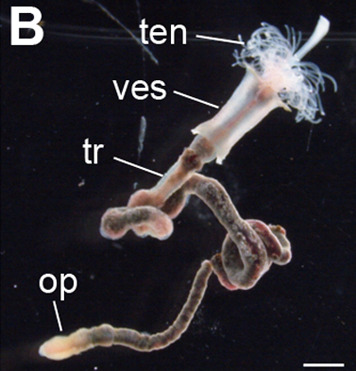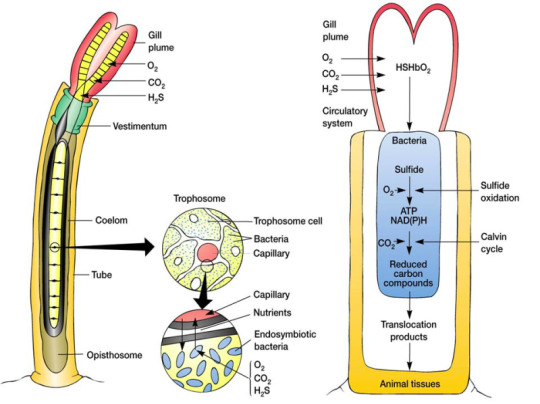#cold seeps
Explore tagged Tumblr posts
Text
Wet Beast Wednesday: giant tube worms
You voted that I would talk about a worm and so I shall discuss the mighty giant tube worms. But first, we need to define what a tube worm is. This is another "no such thing as a fish" situation because there are actually a lot of different things we call tube worms. Turns out the "noodle in a tube" body plan is a pretty successful one. The worms I'm discussing today are members of Siboglinidae, a family of annelids (segmented worms) that was formerly classified as two different phyla until genetic evidence came in. I will primarily be talking about two species: Riftia pachyptila and Lamellibrachia luymesi, who have both adapted to distinct extreme environments in similar ways.

(Image ID: multiple patches of Riftia pachyptila growing from rock at a deep-sea hydrothermal vent. The worms are housed in long, white tubes, some stained yellow. Emerging from the tubes are respiratory organs covered in what appears to be red fur. End ID)
All members of Siboglinidae share a basic body plan consisting of a worm body inside of a mineral tube (side not, I think I will be including an orc or ogre named Sibog in my D&D campaign). The tube is composed of chitin and minerals and is secreted through glands along the body of the worm as it grows from larva to adult. The tube provides the worm within with protection from predators and environmental hazards while also providing support, allowing the worm to lift itself up into the water rather than remain on the substrate. The tube either connects to a solid object or is rooted in the sediment with extensions called roots. The roots are composed of the same material as the tube and can be considerably longer than the rest of the worm, though they are so fragile it is hard to study them. Since the worms often live in large congregations, their roots can twist together is massive mats called ropes. The inside of the tube is where you get into the squishy worm parts. The body of the worm is divided into four regions. The first of these regions I found many alternate names for while researching including cephalic lobe and branchial plume. I'm going to simplify and call it the plume because this segment is composed of one to 200 tentacles that are covered with feathery filaments that can make it look like the plume of a quill pen. The feathery portions of the plume are usually red because they are highly vascularized and filled with blood, similar to a fish's gils. The plume is used for respiration, taking in dissolved oxygen and (depending on the species) other dissolved gasses from the water. In most species, the plume is the only part of the body that extends from the tube. When in the presence of threats, the plume can withdraw into the tube, which can then be close with a structure called the obtraculum, similarly to the operculum found in many other invertebrates like snails. The second body region is the vestimentum. It has a winged shape and is composed of multiple bands of muscle. The vestimentum also contains the heart, a simple brain, and genital pores that release gametes. The third body region, which makes up most of the body, is the trunk. The trunk is the wormiest part of the worm and contains the gonads, the coelom (main body cavity), and the trophosome, which I will come back to later. The last body region is the opistosome, which connects the animal to the tube and is used to store and (maybe) excrete waste.

(Image ID: the tubeworm Lamellicrachia satsuma removed from its tube to show its anatomy. It has a plume made up of multiple feathery white tentacles, the vestimentum is a thick white section with flared tips, the trunk is long, brown, and wormlike, and ends with the yellowish opistosome. The body regions are labeled as "op" for opistosome, "tr" for trunk, "ves" for vestimentum, and "ten" for the plume. End ID. Source)
You'll notice that I didn't mention a digestive tract above. That's because these worms don't have one. Instead of a digestive tract, they have a trophosome, an organ composed of highly spongy tissue vascularized by two main blood vessels. Housed within the trophosome is a colony of bacteria that exists in a mutualistic symbiotic relationship with the worm. The worm provides the bacteria with a place to live and protection from predators while the bacteria provide the worm with all of its nutrition. The bacteria are all chemoautotrophs, gaining all their nutrition from chemical reactions using chemicals in their environment without needing to intake nutrients. In particular, they use oxygen, carbon dioxide, and hydrogen sulfide provided to them by the worm. The worm also provides other elements including nitrogen and phosphorus that the bacteria need. I'm going to be honest with you, I tried to comprehend the chemical reactions involved but it's been a long time since I took chemistry and I was never that good anyway so it's over my head. The short version is that the bacteria produces nutrients and chemicals (primarily carbohydrates and ATP) that it shares with the worm. Waste products are also sent into the worm's bloodstream and are sequestered at the opistosome.

(Image ID: a scientific diagram of the internal anatomy of Riftia pachyptila. Of note is the section showing the trophosome, illustrating it as several yellow, spongy cells filled with bacteria and fed by a capillary. End ID. Source)
The most famous of the tube worms is Riftia pachyptila, which you will recognize if you have ever seen a documentary about the deep sea. They're the ones that look like giant tubes of lipstick. These are the most studied of the Siboglinids and live around hydrothermal vents in the deep pacific ocean. Hydrothermal vents are places on the seafloor where water underground is heated by geothermal activity in the Earth's mantle and then released into the water column, often carrying with it chemicals from deeper in the planet. These vents are hotspots of biodiversity in the deep sea and are hypothesized to play a major role in the origin of life. These ecosystems are among the only ones on the planet where the primary source of energy is not sunlight via photosynthesizing organisms. Instead, chemosynthetic bacteria forms the base of the trophic web, generating energy from the heat and chemicals released by the vents. Riftia requires vents which release sulfur into the water and blanket vents with the right conditions all throughout the Pacific. The lifestyle clearly works for them as they have the fastest grown rate of any marine animal. They can go from a larva to a sexually mature adult of 1.5 meters (4.9 ft) long in 2 years. These worms can reach 3 meters in length (9.75 ft) long, but only get to about 4 cm (1.5 in) in diameter within the tube. When reproducing, males will release blobs of stuck-together sperm called spermatozeugmata that collectively swim towards female worms, entering the tube and seeking out the female's oviduct. The female then releases fertilized larvae into the water. These larvae usually spend a few days in the water column before settling down on the substrate and beginning growth into an adult. However, the larvae have been known to reach newly-formed hot vents up to 200 kilometers away from their parent's vents. We don't know how the larvae find new sites to colonize or how long they can remain in the initial, motile state before succumbing to starvation as the larvae do not have digestive tracts and do not develop their internal bacterial colony until they settle down on the substrate. Once the larva does settle down, it develops its internal colony by intaking bacteria from the water using the plume. Riftia are some of the first organisms to colonize a new vent and play a major role in building that vent's ecosystem. Genetic tests show low genetic diversity amongst and between all colonies, which may be a result of how fast they colonize new vents and the fact that if a vent goes dormant or dies, all of the local worms will die with it.

(Image ID: a cluster of Rifita tubeworms, most of whom have their red, feathery plumes exposed. Some tubes do not have exposed plumes, indicating that either the worm has retracted into the tube or the worm has died. Several crabs are crawling on the tubes. End ID)
The other giant tube worm species I'm spotlighting is Lamellibrachia luymesi. These aren't as flamboyant as Riftia, but can get nearly as large (up to 3 meters) and also play a very important role in their ecosystems, though they are less studied. While Riftia likes it hot, Lamellibrachia is more chill. They live at cold seeps, places in the ocean where hydrogen sulfide and hydrocarbons like methane and oil seep out of the sea floor. Like Riftia, these worms depend entirely on an internal bacterial colony for their nutrition. Oxygen is intaken through the plume, but these worms can't get hydrogen sulfide the same way due to the different conditions. Instead, they absorb the sulfide through their roots. While the hot and cold worms absorb their hydrogen sulfide differently, they both have an adaptation to deal with it: specialized hemoglobin. Most forms of hemoglobin can't carry oxygen in the presence of hydrogen sulfide, which is a problem because that's the whole point of hemoglobin. The tube worms, who need to transport hydrogen sulfide, have specialized hemoglobin that seems to use zinc ions to allow for oxygen to bind to it anyway. The cold seep tube worms also excrete their waste products through the roots, returning it to the sediment. The intake of hydrogen sulfide and sequestering of the wast product in the roots and sediment lets the tube worms play an important role in the cold seep ecosystem. Them intaking the sulfide protects organisms who can't handle it as well and sequestering waste products also keeps it away from organisms who could be harmed by the chemicals in it. Hot vents are inherently unstable places. They are formed primarily in places where two tectonic plates are moving away from each other, exposing the planet's mantle. This exposed spot will eventually cool down and the hot vent will die off. Because of this, hot vent ecosystems grow fast and die young. Cold seeps by contrast are extremely stable and long-lasting. Lamellibrachia luymesi grow very slowly and can live for over 250 years. There's no need to hurry when your food comes out of the ground and won't be going anywhere for a very, very long time.

(Image ID: a colony of Lamellibrachia luymesi. Their tubes are more visibly segmented than those of Rifita, with the top of each segment being noticably wider than the base of the next. The tubes are a pale blue, but switch to white at 2 - 9 segments below the top. Many tubes have brown algae growing on them. The exposed plumes are short, red, and feathery. End ID)
#wet beast wednesday#tube worms#giant tube worms#Lamellibrachia luymesi#Riftia pachyptila#worm#wormblr#hydrothermal vents#cold seeps#marine biology#marine life#annelids#chemosynthesis#zoology#ecology#biology#long post#image described
120 notes
·
View notes
Text


3 notes
·
View notes
Text
I need that neck kiss scene.

#ella's wips#grindeldore#is it anatomically accurate to give him doe sad eyes while pinning for a war criminal? maybe#just realized gellert's hand is too big but that's my years of watching yaoi seeping into my work#ignore the timestamp-I drank cold brew at 7pm
53 notes
·
View notes
Text
(tormented by visions) mapicc dragging zam around his castle by his halo
53 notes
·
View notes
Text
Shit awful day
So I thought to myself to honor our lord and saviour Mari Ibarra and procrastinate using an hour long round trip I'll go get a slushy from a local cafe.
Leaving the house I was crazy dehydrated but I was only half an hour from a delicious and refreshing slushy. Unknown to me there was something on™ in town and this was only clear to me when I was 100 yards away from rickety portable theme park rides and swarmed with people. Fucked up shit should not be allowed, whoever on the local council who keep organising these needs to count their fucking days.
Well at least I can get my slushy? I enter the cafe, two young men sat at a table staring daggers at me for *checks notes* daring to also be in the same area. No fucking slushy machine. Admittedly I had not been in the cafe for years but jesus christ why would you get rid of a slushy machine?! Wah wah kills kids. Don't care. Didn't ask. Want my slushy.
Then I had to walk back through the swarms of people no slushy, looking strange, alone in this world.
After this some little shit heads on bikes came up from behind making noises (monstrous) and I wasn't even dressed particularly weirdly omfg not what I needed at all

Ms paint rendering of what I was wearing
#You should not be giving slushies to children under 8 anyway#No need to ruin it for the rest of us 🙄🙄#It's obviously too cold for them#Can you tell how hormonal I am#Can you feel it seeping through the screen#evil horse posting#live laugh love#I want my fucking slushy#I stg there used to be so many places to get slushies near me#The corner shop that used to have a slushy machine doesn't serve them anymore#fucked up shit#The real ones know my first ever tumblr post was a long form one like this
10 notes
·
View notes
Text
Do you feel that? The way the freezing ice creeps in from the outside. Making your very Soul brittle and easy to break?
7 notes
·
View notes
Text
i need to lay on hardwood. its different. i hate carpet.
9 notes
·
View notes
Text

Cold seep
17 notes
·
View notes
Text


4 notes
·
View notes
Text
''I wasn't aware I was the one leading all of this now.' 'Would you have let your Gith companion go further than she had if I didn't say something.' 'Not likely.' 'If you couldn't trust she'd follow your orders, above her queens even, I might question how much faith I've put in you.' 'And do you.' 'No. Still a needless gamble to take.' 'This whole mess has been one after the other, I needed to know if I could trust her.' 'And if you couldn't!' I slid a dagger, the same taken from her however many days ago, already prepared, coated with stronger poison than she had much chance resisting, 'That's why I brought Wyll in with us.' 'You wanted a witness.' 'I wanted a witness who could be trusted to say who turned on whom. It's not like Lae'zel.' 'More her than you, from what anyone's seen.' 'I can only double-cross any of them the one time before most of them won't follow me quite so willingly...What then for you?' 'I'm a necessary evil.' '...And if the new leader gave you the same priority while we take our only lead to Moonrise, thankfully we have been left with no other options but the one you want as well.... You could control any of us easily enough, or just start dropping protection until the point is understood. Which?' 'Enough, you've made your point.'
(another dialogue only snippet )
#Ilztaun Auvryvirr#squidposting#(in which: the concept got to be addressed. And probably kept considering it is an already direct scene.#(no he doesn't know about Orpheus. An idea someone else is involved. But knowing //no one// trusts them.)#(....but why outside of the obvious exceptions why they're the most true to their word assholes of the group from shared fear of having#one very delicate chance......I mean one of them isn't wrong lol. Ilz......look that paranoia seeps in there....)#(anyway this is why I post pure dialogue drafts sometimes....as cold as the opening should be way too direct to launch into)#(......and thus Lae'zel escapes the one chance she might actually have ended up getting herself killed x-x He will give her so many#fucking chances. Just as many as she wants as long as no deals are signed......whoops he saw the cult. Cares now.)
2 notes
·
View notes
Text
is it normal to have the urge to lock myself out of my dorm building and sit on the porch step in my pyjamas in freezing weather because i somehow belong there or did the stress of getting locked out thursday combined with my general stress levels just do that to me
#moderator sundew#i mercykilled a cockroach who was suffering from poisoning by burying them in snow#they werent dead yet#just couldnt move more than a leg at a time#couldnt walk#writhing in agony#would it be a mercykilling for me too#would it be a mercy killing#to feel the chill#seep closer to my heart again#iwas so cold
2 notes
·
View notes
Text
Why do I see Astarion as the fussiest dad over his child
Obviously down the line after therapy and not ascended of course
24 notes
·
View notes
Text

@a-little-lynx
Ok!!! Here it is, my annotations (version one, at least, with the idea in mind that Sleep doesn’t want Vessel as a chosen one)
Good luck all who try to read my hand writing! Edit: and all my misspellings and typos!! Good luck with that too haha.
Edit: wait😭 tumblr borked the quality, of course… how do I fix this??
#very much so#sleep token#lyric annotations#Think Think Think#idk what else to add. I can feel the cold seeping into my mind. cause the uhhh. eepy’s too take over.#*causing the eepy’s to take over
11 notes
·
View notes
Text
summary of the fic i'm writing: its hot in philadelphia. babe and eugene get handsy on the kitchen floor
#getting difficult to write as the cold seeps in#the thing is im not writing im just rereading and rereading what i have trying to figure out what to change and add#baberoe#i guess
6 notes
·
View notes
Text
t-shirt that says I 💖 ECOSYSTEMS
8 notes
·
View notes
Text





my blossoming career as a shitty phone astrophotographer is going swell. loogit my only "successful" 10s exposures of the famous tsuchinshan-atlas comet !!! + heavily edited ones + Tops of trees + i think thats unukalhai on the top right of the 2nd one. actually i think thats 2 entire ass serpentus stars in the top of the 2nd one lol
#ITS SO COLD OUTSIDEE i sat down so i could rest my phone on my knees . Dew seeped through to my ass. So fucked#tsuchinshan atlas#comet tsuchinshan atlas#c/2023 a3 tsuchinshan atlas
2 notes
·
View notes